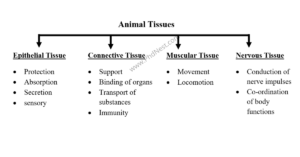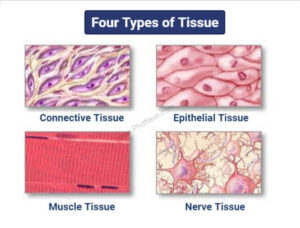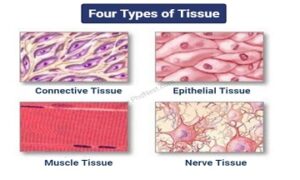What is the Structural Organization in Animals?
All organisms in the animal kingdom are multicellular. However, they do not show the same pattern of organization in cells. Based on the patterns of cellular organization, levels of organization in animals are classified into:
- The cellular level of organization: Animals with this type of cell organization have cells arranged in the form of loose cell aggregates. This type of organization can be observed in sponges.
- Tissue level of organization: The cells of the animals show divisions in cell activities. The cells which perform the same functions are arranged as tissues. Example: Coelenterates.
- Organ level of organization: Tissues in a certain group of animals that have the same function are grouped to form an organ. Each organ has a specific function. Example: Platyhelminthes
- Organ system level of organization: In animals where organs have associated with forming functional systems where each system is concerned with a certain physiological function are observed to exhibit organ system level of organization. Example: Annelids, Arthropods, Echinoderms, Mollusks, and Chordates.
The structural organization in animals or any other lifeform is the same at the fundamental level. Or in other words, all life currently living on earth are made up of cells. And when cells get together, they form tissues. Tissues, in turn, form organs and organ systems
Cells → Tissues → Organs → Organ system
Cell
The cell is the smallest, structural and functional unit of an organism. The cell components are mainly involved in carrying out various life functions. To carry out these functions, cells required specialized structures called cell organelles.
Tissue
Cells similar along with intercellular substances, same function.
Organ and Organ System
Two or more organs perform a common function by physical & chemical interaction.
Cells, tissues, organs – Division of labor.
A collection of tissues form an organ; a group of organs that work together to perform one or more functions is called an organ system.
Every organ is composed of one or more type of tissues. A group of organs working together to perform a common function is called an organ system. Excretory system, reproductive system, endocrine system, circulatory system, respiratory system are examples of organ systems.
Animal Tissues
The structure of the cells vary according to their function. Therefore, the tissues are different and are broadly classified into four types :
(i) Epithelial,
(ii) Connective,
(iii) Muscular and
(iv) Neural.

(a)Epithelial Tissue
The free surface facing either body fluid or outside Environment
Compactly packed with the little intercellular matrix.
1 . Simple Epithelium -Single layer, lining for body cavity, ducts, tubes.
- Squamous – Flattened cell with irregular boundary (diffusion boundary) walls of a blood vessel, air sacs of lungs.
- Cuboidal – Cube-like cells, ducts of glands, tubular part of nephrons secretion & absorption, in PCT has microvilli.
- Columnar – Tall seven slender cells, nuclei at the base, have microvilli lining of stomach, intestine, secretion & absorption.
- Ciliated – Bear cilia on the free surface, more particles/mucus in a specific direction, an inner surface of hollow organs (bronchiole, fallopian tube)
- Glandular – Secretion
Unicellular – isolated cell (goblet cell)
Multicellular – Cluster of cells (salivary gland)
2. Compound Epithelium – Two or more cell layers, protein function. Limited role in secretion & absorption, ducts of salivary gland and pancreas, dry surface of the skin, the moist surface of the buccal cavity, pharynx.
On the basis of mode of pouring of secretion –
Exocrine – Secrete mucus, saliva, earwax, oil, milk, digestive enzyme through ducts and tubes.
Endocrine – Don’t have ducts, produces hormones, directly into fluid.
Cell functions –
Tight – stop substance from leaking
Adhering – cementing to keep cells together.
Gap – communication with each other, rapid transfer of ions, small or big molecule.

- Most abundant, widely distributed
- The function of linking & supporting other tissues.
- In all except blood, secrete fibers of protein- collagen/elastin provide strength, elasticity & flexibility.
- Secrete modified polysaccharides & act as a matrix.
- Soft Connective tissue – Cartilage, bone, adipose, blood.
1 . Loose connective tissue – Cells loosely arranged
Areolar – beneath the skin, support framework for epithelial tissue, has fibroblast (secrete fibers), macrophage, mast cell.
Adipose – Beneath the skin, store fat (excess nutrients that are not immediately converted to fat.
2. Dense connective tissue – Fibers and fibroblast compactly arranged.
Dense regular – fibers in a row between parallel bundles of fibers.
Tendons – Skeletal muscle to the bone, ligament – one bone to another
Dense irregular – fibers oriented differently, (+) in the skin.
ü Cartilage – Solid & Pliable, Resist compression, chondrocytes in a small cavity, a tip of the nose, outer ear joint, hands in adults and limbs, between adjacent bones of the vertebral column.
ü Bones – Hard & non-pliable, Ca salts and collagen fiber, structure framework, support and protect softer tissue, osteocytes in spaces- lacunae, bring movements.
Limb bones – long bones of legs, weight-bearing; Bone marrow – RBC product.
ü Blood – Fluid containing plasma, RBC, WBC, Platelet, transport.
Most cartilages in vertebrate embryos are replaced by bones in adults.
(c) Muscle Tissue –
Long, cylindrical fibers arranged in parallel arrays, composed of myofibril, move the body, maintain position, movements.
- Skeletal – attached to skeletal bones, striated, E.g., Biceps (Parallel fashion)
- Smooth – Taper at both ends (fusiform), no striation, involuntary wall of the blood vessel, stomach & intestine.
- Cardiac – Contractile, intercalated disc (contract as a unit), E.g., Heart.
(d) Nerve Tissue –
- Body responsiveness to changing conditions.
- Neurons – Excitable cell, neurological – protect & support neurons, more than half of volume of neural tissue.
- Neuron stimulated – el. Disturbance – along with PM -neuron ending- stimulation/inhibition of adjacent neurons.
Related Posts
- Phylum Porifera: Classification, Characteristics, Examples
- Dissecting Microscope (Stereo Microscope) Definition, Principle, Uses, Parts
- Epithelial Tissue Vs Connective Tissue: Definition, 16+ Differences, Examples
- 29+ Differences Between Arteries and Veins
- 31+ Differences Between DNA and RNA (DNA vs RNA)
- Eukaryotic Cells: Definition, Parts, Structure, Examples
- Centrifugal Force: Definition, Principle, Formula, Examples
- Asexual Vs Sexual Reproduction: Overview, 18+ Differences, Examples
- Glandular Epithelium: Location, Structure, Functions, Examples
- 25+ Differences between Invertebrates and Vertebrates
- Lineweaver–Burk Plot
- Cilia and Flagella: Definition, Structure, Functions and Diagram
- P-value: Definition, Formula, Table and Calculation
- Nucleosome Model of Chromosome
- Northern Blot: Overview, Principle, Procedure and Results
















